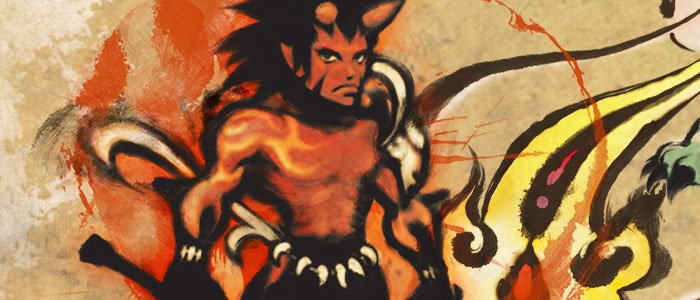[tab:Review]
I love my Vita. I am not usually a handheld guy, but the Vita fits my needs perfectly. The design is great, but what makes it perfect, is the selection of games. Acquire is quickly becoming a Vita regular. Having already put Shinobido 2 under its belt, they now turn to Sumioni: Demon Arts, an artistic platformer for the system that takes advantage of the touch screens in unique ways. Sumioni is a distinctive and beautiful experience that is only marred by its questionable design in some areas.
You play as an Inkdemon known as Agura, tasked with saving Japan. Small feat, right? You will move through various levels fighting enemies and utilizing the Vita’s front touch screen to create platforms, similar to Kirby: Canvas Curse for the Nintendo DS. This uses up ink, which is a meter right below your health. You can refill this with pickups, or by rubbing the back touch screen while Agura isn’t moving. So far, so good.
Attacks are standard fare. You move Agura with the analog stick and attack with the face buttons. You can also perform special attacks by tapping the analog stick left and right, as well as jumping attacks. To be fair, though, most of your combat will consist of simply mashing the main attack button, or by summoning your ink magic. Tapping the left trigger brings up the screen and you can either choose one of the demons and draw a symbol to summon them, or simply draw lines that produce fire to hurt enemies. All of this is very good on paper, and in reality, it works exactly as you expect it to within the game.
There are a total of 30 stages and six endings, which sounds great, until you realize what you have to do to obtain them all. The stages are broken down into paths, and in order to head down a specific path, you have to earn three stars on its predecessor. This is the only way to see all of the endings. Now, that in and of itself isn’t terrible, until you see the save system. There is no autosave, meaning at the conclusion of each level, you have to tap through menus to save the game. OK, still, that all could be remedied by a stage select. Unfortunately, Sumioni doesn’t have one.
What this means is that if you intend to go back and play each level and earn all six endings, you have to save at certain spots, or play the entire game all over hoping you hit the right stars at the right time. Frustration and repetition quickly set in, making an otherwise joyous experience, much less so. The only redeeming factor is that the levels are so short that you can literally see one ending easily in one sitting, the problem is finding the drive to go back and see the others after your fourth or fifth time through the same area.
Don’t get me wrong, though, Sumioni is great in small bursts, and no one can deny its beauty. One look at these screenshots, and you can see the awesome art direction of the title. I love the paint brush-inspired look, and the effects of your magic are gorgeous. The only downside is the interface. I am aware that the Vita focuses on touch controls, but when you have me navigating through screens constantly to save every five seconds, at least let me tap buttons to do so.
Sumioni: Demon Arts is a gorgeous game that plays well and offers a unique experience all around. The frustration of going back to see all it has to offer, though, is a huge barrier to entry. While the price point of $20 is appealing, a simple stage select or a modern save system would have vastly improved the experience. If these things don’t bother you, Sumioni is well worth the investment. As I said, the visuals are stunning, and there really isn’t anything else quite like it currently available on the system.
Review copy of game provided by publisher.
[tab:Screenshots]
[tab:END]

